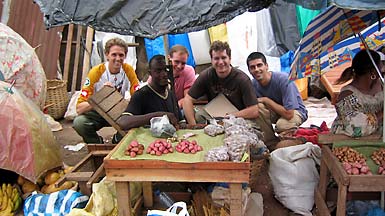 |
Steve Hardgrave, Mike Cipresso, Jonathan Piazza and Loic Comolli join a kola nut reseller at his stall in a Yaoundé street market |
Cracking into the kola nut business: Putting wheels on the science of tree domestication
YAOUNDÉ, CAMEROON – The challenge of protecting the world's dwindling sanctuaries of biodiversity is immense. Providing options and answers that address the complicated reality of rural poverty is also an imposing goal. At first glance, doing both at the same time appears to either require a miracle or an exercise in wishful thinking. People all over the world, however, have begun to realize that the best way to protect the earth's precious resources and rich biodiversity is to ensure that someone's livelihood is connected to the health of the world's forests.
The future of these forests and the future of millions of the world's poorest people are already inextricably linked. Rural poverty is concentrated in many areas where the world's biodiversity is most threatened. More than a billion people now live within the world's 19 forest biodiversity "hotspots" and population growth in the world's tropical wilderness areas is 3.1 percent, over twice the world's average rate of growth. Over 90 percent of those who live on less than a dollar a day depend fully or in part on forest products for their livelihoods.
| |
Slideshow: Adventures in Africa |
By the end of our time in Cameroon, we had become quite educated about the production and commercialization of kola nuts – something we had never heard of only months before. It was very clear to us that ICRAF has done excellent work in developing appropriate technology models for domesticating and harvesting kola and other non-timber forest products (NTFPs). It was also clear that the organization had won the confidence of local farmers by patiently developing strong relationships with them. However, it was also obvious that much more work needs to be done on identifying markets and building strong distribution networks that will make them more accessible and efficient. This "putting wheels on the science of tree domestication" is also a wonderful opportunity for ICRAF to partner with others whose strengths lie in the field of commercialization, as they are still building this expertise internally.
Market obstacles
The most critical aspect of the market for participation by poor producers is the existence of well-organized market intermediaries to assemble their small and irregular surpluses at reasonable cost. However, national NTFP marketing systems in most poor countries are still largely informal and most suppliers operate on a modest scale. There is little development of sophisticated marketing chains (such as cold storage). There is significant price volatility due to limited information flows, high perishability, high seasonality, trade fluctuations, and climatic variability. There is limited added value through small-scale processing. Profit margins are low due to high marketing costs (poor transport, roads, and communications infrastructure). While there are price premiums for good quality and supplies out of the main seasons, there is still relatively little emphasis on quality overall, since many consumers are poor. Volumes traded in many NTFPs, such as medicinals and botanicals, are small, and producers rely heavily on direct market linkages with buyers (Poulton and Poole 2001).
Although we did not extensively research the international demand for kola nut as part of our project, we were not able to identify an attractive market outside of northern Africa and possibly the Middle East. Moreover, the current productive capacity of kola nut farmers, and inefficiencies in the informal distribution network of whole sellers and resellers seriously limit their ability to deliver on any possible large demand for high quality kola nuts outside of the region. It was clear that relationships need to be developed with intermediaries to the same degree they have been developed with producers in order to complete the bridge to market. For example, the absence of financing available to intermediaries limited the amount of kola nut commerce, hurting both intermediaries and producers alike.
Market opportunities
We felt that ICRAF and its partner farmers should focus on the national and regional markets which have a fairly consistent demand for the product. Even here, there are improvements that can be made in the commercialization process. ICRAF, together with local farmers, has worked on developing technologies to speed the process of removing the outer covering from the kola nuts, and that would enable producers to store kola nuts for longer periods of time. Losses due to weevil infestation represent a significant cost throughout the entire value chain, and fluctuation in prices from seasons of abundance and seasons of scarcity are dramatic.
Although we focused our work primarily on the kola nut industry, the same considerations apply to other NTFPs, even if their characteristics may differ significantly. For example, natural, medicinal oils may have a greater potential in higher-priced western markets. Furthermore, fair trade or organic certification may be highly valued in these markets and a feasible business strategy. On the other hand, the market for kola nuts clearly does not value this type of certification. Identifying the market potential for each NTFP, and weighing that against the local capacity to commercialize to that market should be a part of any sustainable agroforestry project, even before the scientific feasibility is explored and expectations are raised among partner farmers.
At the end of our visit, we produced several deliverables that we hope will assist ICRAF and others in furthering both the kola nut cooperative, and the larger field of sustainable and profitable agroforestry. We tried to design tools that could be adapted to a variety of products and contexts, and used the kola nut cooperative in Cameroon as a case study example. These tools include:

